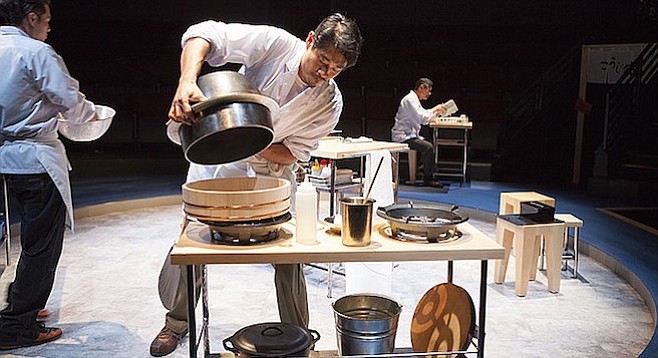 Facebook
Facebook
 X
X
 Instagram
Instagram
 TikTok
TikTok
 Youtube
Youtube

For 35 years, from morning to midnight, Koji has prepared sushi on a “dingy side-street ” in Tokyo. His may have been “the best in a generation,” in fact, and he’s done it without throwing in a single “happy meal.”
Koji and his restaurant (and even quality, ten-year-old tuna, playwright Kimber Lee suggests) are things of the past. But he won’t let go and allow Takashi, his son and 20-year-apprentice, take his place.
Except for 12 months off, Takashi has studied under his strict father, even had to “erase” himself “to make room for him.” Now age 39, Takashi has the skills to become a shokunin — a master, like Toji — and some new ideas to bring customers back to the restaurant.
Tokyo Fish Story dramatizes a changing of the guard. “Dramatizes” may be too strong, since the generally quiet piece serves up big moments in small portions. Maybe because of this, the Old Globe production has a micro-concern for details: selecting appropriate fish, massaging an octopus, preparing rice. Also making coffee, filling a big pot with water, and spilling it out.
Actors mime the latter, but make real sounds. At first the effect has a mystical quality: is the water visible only to the chosen? But after a while one wonders how designers Charles Coes and Nathan A. Roberts do it: where’s the source? — in the pot, the faucet, or some directional gizmo? The search pulls one from the story.
James Saito’s Koji has the solemnity and thoroughness of a shokunin. And Tim Chiou wraps Takashi’s obvious talents in layers of respect for his father. In subtle ways, Chiou shows that Takashi yearns to do the unthinkable, take charge, and slice raw red tuna on a majestic bias.
If Tokyo Fish Story were a meal, Raymond Lee (Nobu) and Tina Chilip (Ama Miyuki) add the spice. Nobu’s a cultural hybrid. He’s a cross between reverence for an ancient tradition and a love of hip-hop, yo. Ama’s a threat: she’s a woman; and she wants to work at a sushi restaurant — a no-no in Koji’s world.
One could wish director May Adrales could have chosen a less cutsie way for Koji to ride his bicycle to the market, and could have picked up the pace here and there — though her choreography of fluid, on-the-job movements is impressive.
Beneath the rich details, and almost a seminar in communication theory (including a scene composed mostly of “mmm’s”), the play moves in predictable ways toward a foregone conclusion.
Playing through June 26


For 35 years, from morning to midnight, Koji has prepared sushi on a “dingy side-street ” in Tokyo. His may have been “the best in a generation,” in fact, and he’s done it without throwing in a single “happy meal.”
Koji and his restaurant (and even quality, ten-year-old tuna, playwright Kimber Lee suggests) are things of the past. But he won’t let go and allow Takashi, his son and 20-year-apprentice, take his place.
Except for 12 months off, Takashi has studied under his strict father, even had to “erase” himself “to make room for him.” Now age 39, Takashi has the skills to become a shokunin — a master, like Toji — and some new ideas to bring customers back to the restaurant.
Tokyo Fish Story dramatizes a changing of the guard. “Dramatizes” may be too strong, since the generally quiet piece serves up big moments in small portions. Maybe because of this, the Old Globe production has a micro-concern for details: selecting appropriate fish, massaging an octopus, preparing rice. Also making coffee, filling a big pot with water, and spilling it out.
Actors mime the latter, but make real sounds. At first the effect has a mystical quality: is the water visible only to the chosen? But after a while one wonders how designers Charles Coes and Nathan A. Roberts do it: where’s the source? — in the pot, the faucet, or some directional gizmo? The search pulls one from the story.
James Saito’s Koji has the solemnity and thoroughness of a shokunin. And Tim Chiou wraps Takashi’s obvious talents in layers of respect for his father. In subtle ways, Chiou shows that Takashi yearns to do the unthinkable, take charge, and slice raw red tuna on a majestic bias.
If Tokyo Fish Story were a meal, Raymond Lee (Nobu) and Tina Chilip (Ama Miyuki) add the spice. Nobu’s a cultural hybrid. He’s a cross between reverence for an ancient tradition and a love of hip-hop, yo. Ama’s a threat: she’s a woman; and she wants to work at a sushi restaurant — a no-no in Koji’s world.
One could wish director May Adrales could have chosen a less cutsie way for Koji to ride his bicycle to the market, and could have picked up the pace here and there — though her choreography of fluid, on-the-job movements is impressive.
Beneath the rich details, and almost a seminar in communication theory (including a scene composed mostly of “mmm’s”), the play moves in predictable ways toward a foregone conclusion.
Playing through June 26
Comments